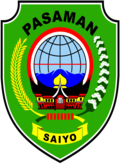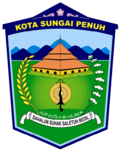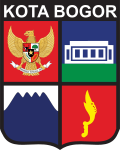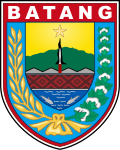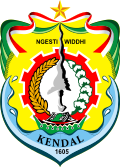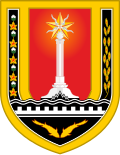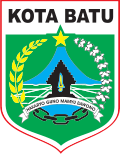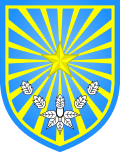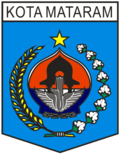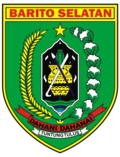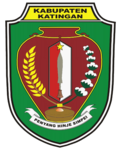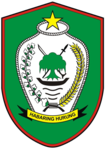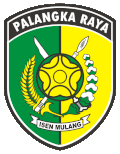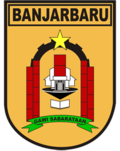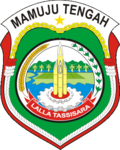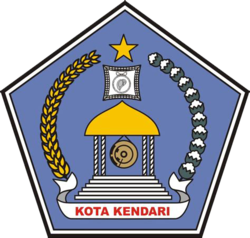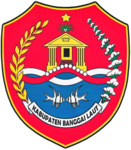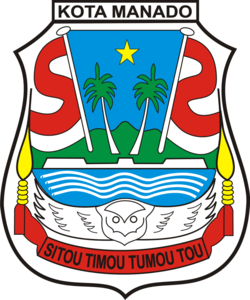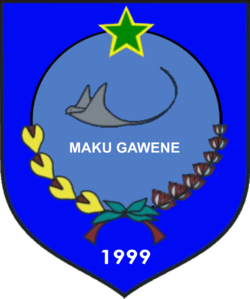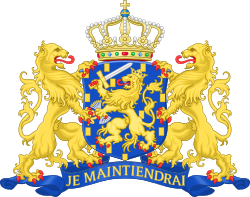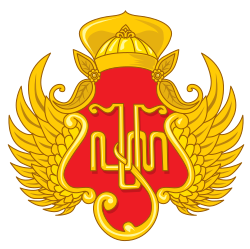| No | Emblem | Name | Description |
|---|
| 1 |  | Coat of arms of Aceh | The Coat of arms of Aceh is called the Pancacita just like its motto, a sanskrit word which means "five hopes" each represented by symbols inside the emblem: justice is represented by scales, heroism represented by a rencong knife, prosperity represented by rice, cotton, and chimney, harmony represented by a mosque dome, and religiosity represented by a book a qalam pen. In addition, white represents purity, yellow represents glory, and green represents welfare. [1] |
| 2 |  | Coat of arms of North Sumatra | A clenched fist wielding a chain connected to a shield represents the determination of the North Sumatran people, a five pointed star, shield, and chain represent the unity of the people to defend Pancasila, a factory, port, rubber tree, oil palm tree, tobacco leaf, and farmer represent the resources of the province, 17 sheaves of cotton, an 8-sided web, and 45 rice seeds represent Indonesia's proclamation of independence day, the Barisan Mountains in the background represent noble personality, a sense of unity, and gotong royong within society, and lastly, the motto "Tekun Berkarya, Hidup Sejahtera, Mulia Berbudaya" means "work diligently, live prosperously, and be noble culturally". [2] |
| 3 |  | Coat of arms of West Sumatra | The emblem contains a mosque and a Rumah Gadang, traditional home of the Minangkabau people. It represents the west sumatran people and their traditional values and the Islamic religion. A star represents the first Pancasila principle: The one Almighty God, the waves represent the dynamic nature of the people, and the motto "Tuah Sakato" means "agreement to enforce the result of consensus decision-making to reach common goals". In addition, white represents purity, red represents courage, yellow represents greatness, black represents resilience and eternity, and green represents hope. [3] |
| 4 |  | Coat of arms of Riau | The emblem is a green shield with 45 links to represent the Indonesian year of independence, five waves represent Pancasila, the ship in the center is a "Lancang Kuning", a legendary boat of the Riau people, which symbolizes the Riau peoples history and their way of life as a people who depend on the sea, while a keris with a serindit head symbolizes heroism and struggle. Lastly, rice and cotton represent prosperity. [4] |
| 5 |  | Coat of arms of Riau Islands | The emblem consists of a yellow five-pointed star representing the first Pancasila principle: The one Almighty God. A chain surrounding the shield represents the unity of the people, a white-sailed yellow boat in the center symbolizes spirit of solidarity and determination of the people to accelerate development of the province, 24 seeds of rice and 9 cottons represent the formation of the province on 24 September 2002, keris with serindit head represent struggle to develop this maritime province to reach prosperity, red Tepak Sireh, a traditional Malay metal container to store betel, used for chewing and various traditional ceremony, it symbolize friendship, 7 waves symbolize 1 July 2004 when the province officially function, the motto "Berpancang Amanah, Bersauh Marwah" means Staked by Trust, Anchored by Dignity [5] |
| 6 | 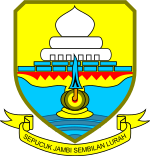 | Coat of arms of Jambi | The emblem consists of a five-sided base symbolizing the Pancasilaic soul and spirit of the Jambi people, a mosque with 6 holes, 5 top foundations, 7 bottom foundations, and a keris representing the birth of the province on 6 January 1957, and the mosque itself representing the religion of the Jambi people. A Keris Siginjai, a legendary weapon from Jambi, symbolizes the struggle and heroism of Jambi people to defeat colonialism and tyranny. A Cerana, a traditional container to hold betel, symbolizes the holiness of the God. A Gong, a traditional musical instrument, represents the spirit of democracy, four lines below the gong represent the history of Jambi from the kingdom era to its formation as province, and the motto: "Sepucuk Jambi, Sembilan Lurah" means that Jambi consists of nine traditional regions. [6] |
| 7 |  | Coat of arms of South Sumatra | In the center of the emblem is a lotus with five petals symbolizing the national ideology Pancasila. The Ampera Bridge is an iconic structure in South Sumatra, while around the bridge, a mountain and rivers represent the geography of South Sumatra. Above the lotus is a traditional South Sumatran roof with 17 points, 8 roof lines, and 45 roof tiles, it represent the Indonesian independence date. The motto "Bersatu Teguh" means "United (we) stands" [7] |
| 8 |  | Coat of arms of Bengkulu | A star represents the One and Only God. Below the star is a cerana, a traditional metal container to hold betel representing tradition, a Rudus, a traditional sword representing heroism, and a Rafflesia arnoldii represent the nature of Bengkulu, rice and coffee symbolize prosperity, 18 waves symbolize the birth date of Bengkulu province (18 November 1968) [8] |
| 9 |  | Coat of arms of Bangka Belitung Islands | The emblem is a five pointed shield symbolizing the Pancasila. In the center is a map of Bangka Belitung representing the land, the people, the government, and the resources of the province. The map are inside a circle representing the unity of the people of Bangka Belitung to confront the globalized world, 27 seeds of rice symbolize the birth of the province based on the Law No. 27/2000. 31 peppers symbolize Bangka Belitung as the 31st province of Indonesia, while rice and pepper also symbolize prosperity. Between the rice and pepper is a tin ingot representing the natural resource of the country that has supported the economy of this region for more than 300 years. The emblem is coloured blue to represent the sea. The motto Serumpun Sebalai means The People of Bangka Belitung are a community (serumpun) working together with a sense of kinship (sebalai) to achieve their goals. [9] |
| 10 |  | Coat of arms of Lampung | The emblem consists of rice and pepper representing the resources of Lampung. A Laduk and Payan represent heroism, and a Gong Gajah Mekhu symbolizes democracy. A traditional Siger crown symbolizes culture and tradition, a traditional umbrella represent protection and the motto Sang Bumi Ruwa Jurai in Lampung language literally means One Land, Two Peoples, which can be interpreted as Sang Bumi Lampung. [10] [11] [12] |
| 11 |  | Coat of arms of Banten | Below the text "BANTEN" is an outline of a mosque dome symbolizing the religious culture of the people. A star represents the first principle of Pancasila: The One and Almighty God, while the tower of the Great Mosque of Banten symbolizes great spirit with the guidance of the God. The Gate of the Kaibon Palace below the tower represents Banten as a gateway to global civilization and international trade. Rice and cotton symbolize Banten as an agrarian province, and the number of seeds refers to date of the Indonesian proclamation of independence. A, black mountain in the background represents the land and resources. A the one horned javan rhinoceros is the provincial animal and symbolizes the persistence of the society to defend justice and protected by law. The rhino ia standing on an airport runway representing Soekarno–Hatta International Airport. A half-gear below the mountain represents development and industry, a blue wave represents the sea, the motto " Iman Taqwa " is a concept in the Islamic faith written on yellow scroll representing unity. [13] |
| 12 |  | Coat of arms of Special Capital Region of Jakarta | Designed by the then governor Henk Ngantung during his tenure. The emblem is five-pointed escutcheon, or shield, to symbolize Pancasila, the Indonesian ideology, with an outline of a gate and Indonesian National Monument to represent Jakarta as a special city, not only as the capital of Indonesia but as a city where Proclamation of Indonesian Independence happened. Rice and cotton are symbol of resources tied with golden rope symbolize unity, wave represent the sea, and the motto "Jaya Raya" which means "Glory and Greatness" written in red to symbolize heroism. The colour gold symbolize the holiness and greatness of Pancasila, white represent purity, yellow and green represent prosperity, and blue background represent the far-reaching sky. [14] |
| 13 |  | Coat of arms of West Java | The emblem is an egg-shaped shield used by a previous kingdom and the background is coloured green to represents the richness of the soil. In the center is a kujang, a traditional weapon of the Sundanese people. The kujang has five holes on it to symbolize Pancasila. There are 17 seeds of rice and 8 cottons representing the date of the Indonesian proclamation of independence on 17 August. Below the kujang is a black mountain representing the terrain of the province which has many mountains. Below it are wavy lines to represent the rivers and seas and beside it is a checkered pattern to represent the rice fields and plantations. Between the wavy and checkered patterns is a white line to represent the dams and canals. The motto is the Sundanese words "Gemah Ripah Repeh Rapih". The first two words mean serene and prosperous, and the last two words mean peaceful and harmonious. [15] |
| 14 |  | Emblem of Central Java | The emblem basic shape remembles that of a "Kundi Amerta", a ceremonial water jug. A five-pointed shape and a star symbolize Pancasila. Borobudur represents creativity, culture, and tradition, and twin mountains symbolize unity between local government and its people. The mountains, sea, and green background represents the natural geography of this province with its various resources as a source of livelihood for the Central Javan People. Below the star is a bambu runcing or sharpened bamboo, a traditional weapon to symbolize heroism, rice and cotton symbolize prosperity, red and white pennant on top symbolize nationalism. The motto "Prasetya Ulah Sakti Bhakti Praja" is a sanskrit word which means A vow and devotion with all might to build the nation and the country. [16] |
| 15 |  | Emblem of Special Region of Yogyakarta | The emblem is called golong-gilig because it has a circle (golong) and a cylinder (gilig), which represent the philosophy of life. It is related to the first principle of Pancasila, "The one almighty God", as represented by a five-pointed golden star. The second principle, "Humanity", is represented by a winged central pole/monument (Saka guru), the third principle, "Unity", is represented by a red circle surrounded by a white circle, the fourth principle "Democracy" represented by an object below the central pole called an "Ompak", which is a traditional carved stone foundation with a lotus pattern, and the fifth principle, "Social justice", is represented by rice and cotton. The other meanings that can be found in this emblem are religion, education, and culture which is represented by a star and jasmine below it with three sepals. Within the red circle is sentence written in Javanese script: "Rasa Suka Ngesti Pradja, Yogyakarta Terus Mandiri" which means "with a sense of optimism to build Yogyakarta that stands on its own" [17] |
| 16 |  | Coat of arms of East Java | The emblem is a shield to symbolize peace and security, a star represents "The One and Almighty God", the Heroes Monument symbolizes the heroism of the people during the Battle of Surabaya, a volcano represents the geography of the province, around the heroes monument is a temple (candi) gate to symbolize struggle and patriotism, while a river, farmland, rice and cotton represent prosperity, in addition the rice and cotton have numerical significance that symbolize Indonesian date of Independence, the gear represents industry and sense of friendship to outsiders, and the motto "Jer Basuki Mawa Beya" means "Sacrifice is needed to achieve goals". [18] |
| 17 |  | Coat of arms of Bali | The emblem is pentagon to represents Pancasila, inside the pentagon is five-pointed star to represents "The One and Almighty God". Margarana monument is symbolizing heroism of Bali people, the monument itself is a memorial for Battle of Margarana, the struggle of Balinese led by I Gusti Ngurah Rai to prevent the restoration of Dutch rule. Candi bentar, a traditional temple gate to symbolize religiousness. Chain represents unity and gotong royong, Balinese fans to represent culture and tradition, red lotus represents the throne of Shiva, rice and cotton represent prosperity and the motto "Bali Dwipa Jaya" means Glorious Bali Island, in addition the color blue represents solidarity, yellow represents glory, white represents purity, and red represents courage. [19] |
| 18 |  | Coat of arms of West Nusa Tenggara | The emblem is a shield to represents heroism and culture, inside the shield is star to represents Pancasila, Chain represent unity, rice and cotton represent prosperity, volcano represents Mount Rinjani, Dome shape represent religiousness, inside the dome is Javan rusa, the provincial animal. In addition, the color blue means loyalty, green means prosperity, white means purity, yellow means glory, black represent immortality, and red means courage to defend justice and truth. [20] |
| 19 | 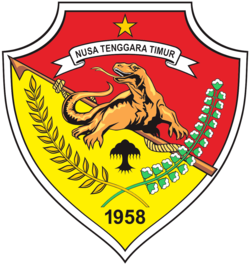 | Coat of arms of East Nusa Tenggara | The emblem is red-yellow coloured shield, inside the shield is a star to symbolize "The One and Almighty God", Komodo dragon, the provincial animal symbolize the natural richness of the province, rice and cotton represent prosperity, spear represents glory and greatness, banyan tree represents unity, and the text "1958" is the birth year of this province. [21] |
| 20 |  | Coat of arms of West Kalimantan | The emblem base is a five-pointed shield to represent Pancasila, the shield are coloured light green to represent fertility of the land. Inside the shield base is traditional Dayak shield, mandau, and keris to represent culture and tradition, each of them coloured white to represent holiness and purity. Straight white line in the center is symbolizing the equator which crossed the province. Rice and cotton represents prosperity. There are 17 cottons, 8 flames, and 45 rice seeds to represent Indonesia date of Independence. The rice and cotton are tied white four-pointed ribbon to represent "Catur Karsa" or four principles: sincerity, honesty, gotong royong, and kinship. The motto "Akcaya" is an Old Javanese word which means "Will never perish" written on a white three-fold scroll to represent three foundations of national revolution or universal ambition of Indonesian nations: Unity of Indonesian from Sabang to Merauke, spiritual and material justice and prosperity to society, and strengthen the relationship between all nations and states. [22] |
| 21 |  | Coat of arms of Central Kalimantan | The emblem consists of sacred green jar (Balanga) to represents the potential resources of the province, the jar is surrounded by yellow rope made out of plant roots called "Tali Tengang", this rope is commonly used by fishermen and also used in traditional ceremonies, it represents unbreakable solidarity, the rope has 57 knots to represent the birth year of the province, inside the jar is traditional Dayaks shield or "Taliwang" and behind it is Mandau and Sipat or Blowgun to represents vigilance and endurance of the society to defend the country from inside and outside threat, the Taliwang are painted with pattern called "Haramaung Batulang, Pengadien Balikur Talawang" which means "Only tiger with muscle made out of wire, and bone made out of steel can stands against everything" it represents the struggle of the people to achieve justice and prosperous society. Rice and cotton represent prosperity, star represents Pancasila. Above the shield is Hornbill or "Enggang" the provincial animals to symbolize environmental protection, below the shield is musical instrument called "Galantung" which used to call people before announcing something or ceremonial purposes, it represents tradition and unity. Lastly, the motto "Isen Mulang" which means "Never Give Up" . [23] |
| 22 |  | Coat of arms of South Kalimantan | Shield represents vigilance and defense of the people, star represents the first principle of Pancasila: "The One and Almighty God", the house in the center is called Bubungan Tinggi, the traditional house of the Banjar people to symbolize culture. Diamond, rice, and rubber wood symbolize the resources of the province. The white ribbon represents the linkage of all aspect of life: food, clothing, culture, belief, etc. In addition, the color red represents courage, yellow means hope, green means fertility, white means purity, black means persistence. Lastly, the motto "Waja Sampai Kaputing" means "Keep Strong Until The End". [24] |
| 23 |  | Coat of arms of East Kalimantan | Shield represents defense of the people, star represents the Pancasila, traditional Dayak weapons like shield called "Telabang", mandau, and blowgun represents readiness and competence. The weapons are surrounded by oil droplets and dammar resin to represent resources of the province, if the droplet and resins amount were added it becomes 17 which is the date of Indonesian independence. Above the shield is the name of the province surrounded 24 knots of rattan to represents the birth day of the province: 1 January 1957 (1+1+1+9+5+7=24), and below the shield is the motto: "Ruhui Rahayu" which means "Perfect harmony with the blessing from God", in addition the color green means fertility, gold means holiness and greatness, red means courage, white means purity, and black means sincerity. [25] |
| 24 | 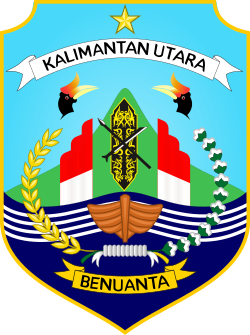 | Coat of arms of North Kalimantan | The emblem contain star represents the first principle of Pancasila: "Belief in One and Only God", traditional Dayak, Bulungan, and Tidung weapons like shield, mandau, and spear represents harmony between various culture and readiness to confront challenge from inside and outside, rice and cotton represents prosperity, the blue wave represent the potential resources from the sea and its shape represents the dynamics of society, 4 white waves represents the four major river (Kayan, Sesayap, Sembakung, and Sebuku) of the province that connects the people of the hinterland to the coast and border, the red and white gate represent North Kalimantan as the frontier of Indonesia as it is bordering the neighboring Malaysia, and the motto "Benuanta" means "Our land for us to develop to achieve prosperous society". In addition the color blue means beauty, peace, and prestige, green means fertility and growth, yellow means holiness and greatness, red means courage and strength, white means purity and honesty, and black means sincerity and protection. [26] |
| 25 |  | Coat of arms of West Sulawesi | The emblem is a white jars that contain various object, in the center is circling patterns called "Meander Kalumpang Tegak", there are 14 outer and inner patterns, it represents the 14 historical Mandar kingdom within West Sulawesi that kept being united until today, its colored gold to symbolize prosperity, tranquility, and holiness. Within the meander pattern is the geography and resources of the province represented by mountains, farmland, and sea. On the sea lies traditional Mandarese boat called Sandeq facing forward to symbolize the people that keep moving forward, the boat colored white to represents genuine heart to change for the better. On the sea is 5 white waves to symbolize the five regency that exist during the province formation. Jasmine and rice tied with red silk represents prosperity, purity, beauty, openness, fragrancy, and manners. Above the mountain is "Doe Pakka" or Trident with each prongs represents courage, sharp mind, and knowledge, the trident is straight to represents strength and honesty, and colored black to represents humility. Above the trident is umbrella to represents protection, and above it is a star to symbolize Pancasila and hopes. Lastly, the motto "Mellete Diatonganan" which means "Following the Truth" written on a red and white scroll that represents the country. [27] |
| 26 |  | Emblem of South Sulawesi | The emblem is a reminiscent of socialist heraldry design. It contains star represents the first principle of Pancasila: "The one and almighty God". 17 seeds of rice, 8 seeds of cotton with 5 points on the fruit and 4 points of its leaves to symbolize date of Indonesian independence on 17 August 1945. Badik, the traditional dagger, represents heroism and vigilancy to defend the country. The mountains, village, and rice fields symbolize prosperity and fertility. Below the badik is Fort Somba Opu viewed from above to represents defense against imperialism and neocolonialism, within the fort includes three emblems: A traditional pinisi boat representing the history of its people as seafarers that cross the ocean and symbolize persistence to continue the goals of Indonesian independence, the gear and hoe representing the province's industry and agriculture, and the coconuts represent the resources of the province. Lastly, the motto "Todo Puli" written in Lontara script means "Unshakable faith" [28] |
| 27 |  | Emblem of Southeast Sulawesi | The emblem is pentagon-shaped to symbolize Indonesian ideology Pancasila. Inside the emblem is rice and cotton to represents prosperity, unbroken chain made out of 27 links to represents unity and its birth date on 27 April. Within the chain is a head of endemic animal called Anoa to represents tenacity and agility. And lastly, the color white represents purity and the other color represents all the regency that exist during the province formation: Yellow represents Muna Regency which is rich in teak, brown represents Kolaka Regency which is rich in nickel, black represents Buton Regency which is rich in asphalt, and green represent fertile land of Kendari Regency, now renamed Konawe Regency to prevent confusion with Kendari City. [29] |
| 28 |  | Coat of arms of Central Sulawesi | The emblem are shaped like heart to symbolize the emblem meaning are derived from the heart of the people itself. The central part of the emblem is coconut tree which symbolize the resources because all parts of coconut tree are useful to human, it also represents sacrifice to achieve goals, tranquility, and persistence. The coconut tree has five leaves and five fruit to represent Pancasila, above it is a star to represents its first principle: "The One and Almighty God". Waves represent the maritime culture of the province. Rice and cotton represents prosperity, it also have numerical significance to represents the province's birth date on 13 April 1964. In addition, the color blue represents loyalty and hope, yellow represents wealth and glory, green represents fertility, brown represents tranquility, and red represents courage. [30] |
| 29 |  | Coat of arms of Gorontalo | The emblem to some extent was inspired by its namesake capital Gorontalo City. The emblem is colored purple which is one of traditional color in Gorontalo. Within the emblem is five-pointed star that represents Pancasila and rice and cotton that represents prosperity. In the center is white maleo egg and wings, the endemic bird that can be found all over Sulawesi, it represents hope like a bird that soar in the sky. Within the egg are coconut trees that represents its economy, Otanaha Fortress and book represent traditional proverb: "Adat bersendikan sara', sara' bersendikan kitabullah", which means traditional laws are based on religious laws, and religious laws are based on the Quran. Below the egg is the name of the province on red scroll and chain to represents unity. [31] [32] |
| 30 |  | Emblem of North Sulawesi | The emblem are pentagon shaped to symbolize Indonesia ideology Pancasila. Within the emblem are 45 seeds of rice on the left, 8 nutmegs and 17 cloves on the right, all of them symbolize the Indonesian Independence proclamation on 17 August 1945. In the center is 23 corn seeds encircling a coconut tree with 9 leaves, 6 roots, and 4 seeds just outside the corn circle, it represents the birth of the province on 23 September 1964. The corns, coconut, nutmegs, cloves, and rice all represents the resources of the province. In addition the various color on the emblem represents fertility, loyalty, glory, courage, persistence, and tranquility. [33] |
| 31 |  | Coat of arms of Maluku | The emblem is called "SIWALIMA" just like its motto, it's the philosophy of the Moluccans to unite the different groups to achieve prosperity. Within the emblem is sago palm leaves, sago is the staple food of Moluccans, and coconut leaves both to represents resources and life. In the center are spear to symbolize heroism, pearl to represents marine resources. Mountain, nutmeg, and cloves to symbolize the land and forest resources, sea and boat to represents everlasting unity. There are 17 coconut leaflets, 8 pearls, and 45 sago leaves, all of them represents the Indonesian date of Independence on 17 August 1945. [34] |
| 32 |  | Coat of arms of North Maluku | The emblem consist of various objects, the palm leaves, cloves, and nutmeg represents prosperity. Star represents the first principle of Pancasila: The one almighty God. Mountain represents the land and its resources, sea and boats with radiant star represents unity. Traditional shield called Salawaku crossed with Parang blade represents heroism. The number 1999 represents the birth year of the province. And lastly, the motto: Marimoi Ngone Futuru which means United we stand. [35] |
| 33 |  | Coat of arms of Southwest Papua | The emblem consists of shield, which represents the province as protector of the people. The white star represents the first principle of Pancasila: "The one and almighty God". Rice and cotton represents prosperity and welfare, and at the bottom end of them there is Kain Timor, a traditional cloth, which represents the unity of Doberai people. The chains represent unity, and the Cicinnurus respublica head on top of it symbolized the Provincial Government. The traditional stilt house symbolized the province capability to accommodate the people of Indonesia and abroad. The mountains, sea and island chains represents the ecological diversity of Southwest Papua, with the flaming oil and natural gas tower represents the natural resources of the province. The three stones symbolized the "Custom, Religion, and Government". The red-white ribbon represents the province as part of Indonesia, with the motto Bersatu Membangun Negeri on it means Unite to Build the Nation. [36] |
| 34 | 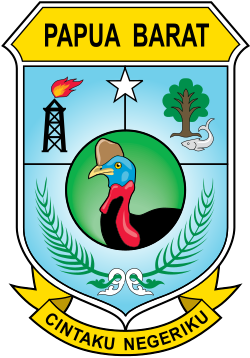 | Coat of arms of West Papua | The emblem is a five-pointed blue shield to represents Pancasila with its five principles that will protect the people. Within the shield is a white star to represents first principle of Pancasila: The One and Almighty God. The shield is divided into three blue regions that symbolize the element of West Papua: Religion, Government, and People/Tradition, each of them work together to achieve common goals. The first region are depiction of gas flare found in oil plants to represents its mineral and petroleum resources, the second region depict a tree and a fish to symbolize the land and marine resources, the third region depict sago palm leaves with 12 leaflets on the right and 10 leaflets on the left, tied together with two karerin carvings of the Biak people both depicting number 9, it symbolizes the birth of the province on 12 October 1999. In the center of the shield is green circle with cassowary head to symbolize the province location as the "head and neck" part of the New Guinea island, it also represents courage, strength, persistence, and unity to achieve common goals. Lastly, the motto: Cintaku Negeriku is an Indonesian word which means My Love, My Country. [37] |
| 35 |  | Coat of arms of Central Papua | The emblem consists of five pointed shield to symbolize Pancasila with the star itself represent the first principles which is belief in the one and only God. The emblem is surrounded by red and white border that symbolize the country. The blue and white mountain is Puncak Jaya that is famous for its snow-capped peak, it symbolize peace, strength, and resilience. The blue and green color on the shield respectively represent the sky and fertile soil. The ocean represent perseverance, patience, and loyalty. In the center is a noken or traditional woven bag and in the front of it are stone axe and sago harvester, both are important tools for locals and each symbolize principle and authority. 25 rice and 7 cotton represents 25 July as the anniversary date of this province. The motto Gerbang Cenderawasih literally means "Gateway of Bird-of-paradise", the bird-of-paradise are endemic bird in the Papua island. The motto is actually a backronym for Gerakan Pembangunan yang Cepat, Nasionalis, Damai, Sejahtera, Wibawa dan Kasih which means "Action for Development, that are Rapid, Nationalist, Peaceful, Prosperous, Authoritative and Loving". This motto represents a guiding principle for the civil service in the Central Papua government to provide effective service to the people of the region while upholding the values. [38] |
| 36 |  | Coat of arms of South Papua | The five-pointed shield represents the spirit of the people in protecting the country. The yellow star symbolizes the first principle of Pancasila: "Belief in the One and Only God," as well as promoting religious tolerance. The four arrows represent the original regencies that formed this province. The red and white spearhead pointing upwards symbolizes courage and swift action in all aspects of defense, reflecting its status as the easternmost border of Indonesia. The diamond represents the power and love of the people, as well as the beauty of the land and its potential. The 30 grains of rice and six cotton balls symbolize the birth date of this province, June 30. The rice, cotton, and sago leaves signify prosperity. The traditional Papuan musical instrument, the tifa, symbolizes community togetherness in building South Papua. The four tree roots at the bottom, patterned like a river, represent the river as an important transportation method for the province, connecting the hinterland with the coast. The motto Maju Negeriku means "Onward my Country". [39] |
| 37 |  | Coat of arms of Highland Papua | The emblem is five-pointed shield to represents defense and the Indonesian ideology Pancasila. The mountains and valleys represent the abundant natural resources of the Lapago customary region within the province, while the rivers symbolize the fertile soil in the province. The watchtower, which customarily was used to scout for enemies during a tribal war, stands for the hope that the region will give birth to leaders who have a great vision and mission for the province's better future. Honai traditional house represent the tribes of Highland Papua. It also stands for being of one heart and one mind in solving various problems. The noken bag symbolize women's role in developing the province. The 25 wheat grains, 7 cottons and year "2022" represent the establishment of the province on 25 July 2022. The 8 red-white ribbons represent the eight regencies of the province within the frame of Republic of Indonesia. The motto Bangkit Bersama Membangun means Rise Together to Develop. [40] |
| 38 | 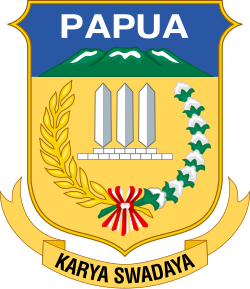 | Coat of arms of Papua | The emblem is five-pointed shield to represents defense and the Indonesian ideology Pancasila. The base colour of this emblem is gold represents glory and wealth of the land, blue represents marine resources, and the yellow border represents confidence to achieve all goals. In the center of the emblem is three monuments that stands on 6 upper foundation and 9 lower foundation, it represents the success of Operation Trikora and "PEPERA" or Act of Free Choice to unite Western New Guinea with Indonesia in 1969, the color white and black represents peace and purity. 17 seeds of rice and 8 cottons tied by red ribbon knots with 4 loops and 5 ends symbolize unity of the nations and country with the spirit of Proclamation of Indonesian Independence on 17 August 1945 to achieve just and prosperous society. Three mountains on the background represents the geography of the province, the colour green represents fertility of the Papuan island. Lastly, the motto Karya Swadaya means Work with one's own might. [41] |



































































































